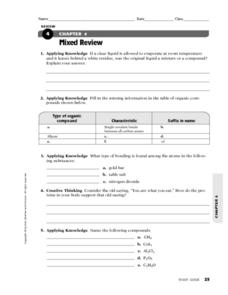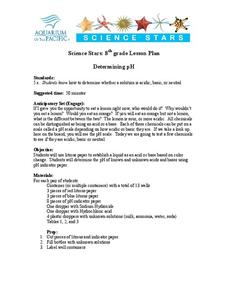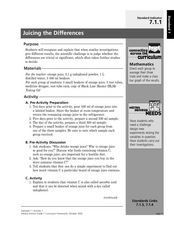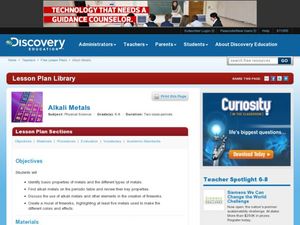Curated OER
GCSE Module 6 Revision Guide-Chemistry-Oil, Fossil Fuels and Earth's Atmosphere
In this oil, fossil fuels and Earth's atmosphere learning exercise, students answer 3 questions about the origin of oil and its uses, the effects of burning oil and fossil fuels on the Earth's atmosphere and the origin and maintenance of...
Curated OER
Elements of Chemistry: Solids, Liquids and Gases
Young scholars predict if icebergs melting has an effect on the sea level rising. In this global warming lesson students complete an experiment to see the effects of melting icebergs and write a conclusion on their data collected.
Curated OER
Electrostatics
Students explore charges using balloons and soap bubbles. In this chemistry instructional activity, students analyze the Van de Graaf generator to see how charges flow using charged particles, static electricity and lighting. This...
Curated OER
Hess's Law
Pupils solve chemical equations. In this chemistry lesson, they balance chemical equations after completing a lab. They can use a TI for this assignment.
Texas Instruments
Measuring Air Pressure Lab
Your class can investigate the weather through an experiment. In this chemistry lesson plan, learners collect data on air pressure and relate it to the weather. They collect data with the TI containing a barometer probe.
Curated OER
Elements Compounds and Mixtures
In this science worksheet, students apply science basic knowledge of chemistry to the puzzles that are listed for the four parts of the sheet while focusing upon the identification of a metalloid.
Curated OER
Common Ions and Their Charges
In this chemistry worksheet, students can use the table to observe and name the common types of ions and determine the charges to explain the gain or loss of electrons.
Curated OER
Atoms and Static Electricity
For this chemistry worksheet, students learn about atoms and static electricity. They read about these topics and then use what they learned to answer the 11 questions on the page. The answers are on the last page of the packet.
Curated OER
Minerals and Rock Cycle Review
In this minerals and rocks worksheet, students answer questions about the chemistry of minerals, scratch tests, rocks and the rock cycle, and erosion and deposition.
Curated OER
Mixed Review
In this chemistry worksheet, students solve chemical equations and define terminology using previous knowledge. There are 8 review questions.
Curated OER
Interactive Quiz 2
In this chemistry interactive quiz, students answer 15 multiple choice questions on chemical bonding, enthalpy and Lewis structures.
Curated OER
Baking Soda and Vinegar Chemical Reaction
Students conduct experiments by mixing baking soda and vinegar. In this chemistry lesson, students complete three different experiments involving these two substances. They find that the chemical reaction does not change and will be...
Curated OER
Scream for Ice Cream
In this chemistry lesson plan, students create their own ice cream. Students discuss what would have happened if they had used different ingredients.
Curated OER
Keep Your Bubbles Up
Students investigate design and the correct use of technology. In this chemistry instructional activity, students investigate the Bernoulli Principle using hands on bubble making. They link the principle that keeps the bubble aloft to...
Curated OER
Introduction to the Periodic Table
Eighth graders investigate the different elements of the Periodic Table. For this chemistry lesson, 8th graders pick an element to research, then present to the class using a powerpoint presentation or a poster.
Curated OER
How the Earth's Atmosphere Formed - Its Origin
In this chemistry instructional activity, students explore the formation of the Earth's atmosphere to answer 24 fill in the blank questions. They select the answer from the word list given.
Curated OER
Determining pH
Eighth graders explain the difference between acids, bases and neutral solutions. In this chemistry lesson, 8th graders describe the properties of each. They determine the pH of an unknown solution using the indicator paper and pH scale.
Curated OER
Juicing the Differences
Seventh graders investigate the vitamin C content of orange juice. In this chemistry lesson, 7th graders analyze the variables that cause result variation in their experiment. They design a new experiment to test variables in question.
Curated OER
A Plop and Fizz
Seventh graders perform an experiment to determine the effect of temperature on reaction rates. In this chemistry lesson, 7th graders take measurements and record data. They create a graph and analyze results.
Curated OER
The Noble Gases
Students identify the different elements that belong to the Noble Gas family. In this chemistry activity, students design a neon sign. They research how they are made and share their work with the class.
Curated OER
Other Metals
Middle schoolers identify the properties of transition metals. In this chemistry lesson, students research facts and uses of one aluminum product they choose. They create an advertisement highlighting aluminum's useful properties.
Curated OER
Alkali Metals
Middle schoolers explore the unique properties of alkali metals. For this chemistry lesson, students create a mural of fireworks display after researching its different element components. They write a brief description about an alkali...
Curated OER
Halogens
Students identify the elements that belong to the halogen family on the periodic table. In this chemistry lesson, students describe the common characteristics of elements in this group. They research about hydrochloric acid's effect on...
Curated OER
Catalase and Catalysis
Learners explore enzyme catalysis through a series of experiments. In this chemistry lesson plan, students determine the factors affecting catalysis. They explain the different uses of this process.
Other popular searches
- Organic Chemistry
- Chemistry Chemical Reactions
- Chemistry Periodic Table
- Chemistry Equations
- Chemistry of Life
- History of Chemistry
- Chemistry Lesson Plans
- Organic Chemistry Projects
- Food Chemistry
- Chemistry Current Events
- Chemistry of Soap
- Water Chemistry

























